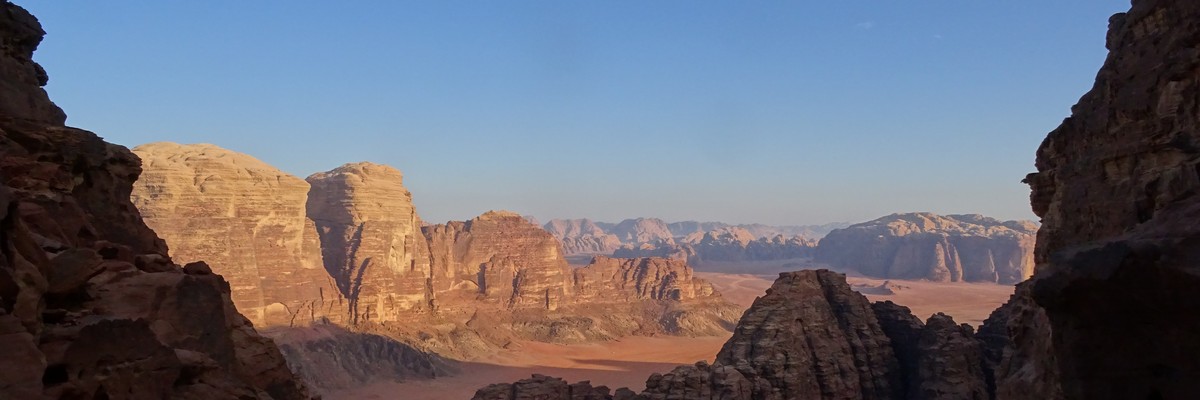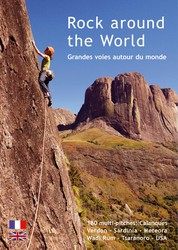Seasonality
Summary
Sandstone trad climbing in another world.
Description
The Wadi Rum Protected Area is a vast desert area in southern Jordan, about an hour's drive north of Aqaba. Wadi Rum isn't too far from the ancient Nabatean capital of Petra (a UNESCO World Heritage Site, as is Wadi Rum). It is full of massive sandstone rock formations, with a near-limitless number of climbing routes, many yet to be discovered. While there is climbing right near Wadi Rum Village, the real reason to visit Wadi Rum is to go deep into the desert to experience the vastness.
To the south of Wadi Rum, on the Red Sea, is the resort city of Aqaba. The city has hotels at all price points and stores that sell food and anything else that you need. If you are interested in diving or snorkeling, great swims can be had in the Red Sea. There are numerous dive companies in Aqaba that can set you up.
Most of the classics were established in the 80s by solid climbers and subsequent traffic may have changed a few holds. Therefore the TH guide book grading could feel a bit stiff to the uninitiated, especially since they use French sport grading as the measure. Crack climbers might have a different opinion.
Guidebook "Treks and Climbs in Wadi Rum, Jordan" by Tony Howard, 4th edition 2007, ISBN 9781852842543 (sold out)
Approach
There are two commonly used options for getting to Wadi Rum, depending on which airport you fly into:
Fly into the capital city of Amman and travel about four hours south to Wadi Rum Village. In 2019, a taxi from the airport in Amman to Wadi Rum Village cost about 90-110 JD one way. It is also possible to rent a car and drive yourself. Many of the climbs are out in the desert and you'll need a Bedouin guide to drive you to them (tourists aren't allowed to drive alone out in the desert in the Wadi Rum Protected Area).
Fly into the resort city of Aqaba, on the coast of the Red Sea, and take a taxi north to Wadi Rum. In 2019, the standard taxi fare between Aqaba and Wadi Rum cost about 20-30 JD one way. You can also rent a car and drive yourself. Many of the climbs are out in the desert and you'll need a Bedouin guide to drive you to them (tourists aren't allowed to drive alone out in the desert in the Wadi Rum Protected Area).
The website for the Wadi Rum Protected Area is www.wadirum.jo.
As of April 2019, you could camp up by the base of the wall at Jebel Rum (about a 20-minute hike up above town with a big pack), stay in a variety of homes and yards in Wadi Rum Village or go camp way out in the desert. Unless you only plan to climb on the cliffs that are right above town (Jebel Rum), you'll need to hire a local Bedouin guide service. Depending on your budget and objectives, they will set you up with transportation and all the logistics you might need (a camp, a guide, food and water, etc.).
As an example, in March and April 2019 we stayed at two different houses in the village for 15-25 JD/person/night. Both places included breakfast and dinner, a bed and hot showers. The higher-priced place was nicer than the cheaper place, but both were fine. On the same trip, we also stayed at a Bedouin camp about 20 minutes out from the village. For 50 JD/person/night we had three meals per day and transport to wherever we wanted to go (climbs, hikes, seeing inscriptions and springs, stopping for photos, etc.). Daily transport from Wadi Rum Village to incredible climbs like The Haj (5.9) and Merlin's Wand (5.10) will cost roughly 30-60 JD per day. Climbs like these are really the reason you'd want to visit Wadi Rum, otherwise, you might as well save the airfare and climb at Red Rocks in NV. Build funds into your budget to go to these remote climbs or you'll really miss out.
Bedouin guides like Kahled Aodh (khaled.desert1@yahoo.com /cell: 07 7720 4215) or MoonRock Camp / Mamdouh (WhatsApp: +962.7.7959.1577) know the climbs well enough that you can simply ask to be taken to a specific climb. Other guides know the area well but may not know where specific climbs are located (i.e.: they'll know where Barrah Canyon is, but maybe not the climb Merlin's Wand).
As of May 2022, the entrance fee to Wadi Rum was 5 JD/person. This fee is covered if you buy a Jordan Pass before arrival in the country (see jordanpass.jo). Note that as of 2022, US citizens need a visa to enter Jordan. Purchasing the Jordan Pass waives the visa fee (appx $56 US). You can buy the Jordan Pass online for $100-115, then send proof of the purchase to the Jordanian Embassy in DC and get your visa for free. This process takes about 7-10 days.
Bring sunglasses, sunscreen, a sunhat and get yourself a 'Hutta' to protect your face from the sun and sand. There's lots of loose rock at Wadi Rum, so a helmet is highly advisable. The rock is a fairly soft sandstone and everything is sandy. Without care, you can trash ropes very quickly. Also bring some chunks of cord and/or webbing to replace sun-baked anchors material you may encounter.
Nearby, the archaeological site of Petra is not to be missed. Add another day or two to your trip to explore this ancient Nabatean city. Again, the Jordan Pass waives Petra entrance fees. If you flew into Amman, it's easy to see Petra, the Dead Sea and a host of other cultural sites on your way to/from Wadi Rum. Taxi drivers take hundreds of people to these places every day as they travel between Amman and Wadi Rum.
The people of Jordan are extremely friendly and helpful. Be respectful of their culture by dressing appropriately (no shorts or skimpy clothing) and being polite. You are visiting a very special place that is much different than the US.
Ethic
Sandstone becomes brittle when wet because it absorbs water, this effects its internal structure. Once the rock surface is totally dry, you need to wait another 24 hours before climbing, this gives time for the absorbed water to also evaporate and the rock to regain its strength.
History
Wadi Rum has been inhabited by many human cultures since prehistoric times, with many cultures — including the Nabateans — leaving their mark in the form of rock paintings, graffiti, and temples. As of 2007[update], several Bedouin tribes inhabit Rum and the surrounding area.
In the West, Wadi Rum may be best known for its connection with British officer T. E. Lawrence, who based his operations here during the Arab Revolt of 1917–18. In the 1980s one of the impressive rock formations in Wadi Rum was named "The Seven Pillars of Wisdom" in memory of Lawrence's book penned in the aftermath of the war, though the 'Seven Pillars' referred to in the book actually have no connection with Rum (see the Foreword in the book).
The area was "discovered" as a climbing area in 1984 by British climbers Tony Howard, Di Taylor, Mick Shaw, and Al Baker. Howard and Taylor have since written two guidebooks: Treks & Climbs in Wadi Rum and Jordan - Walks, Treks, Caves, Climbs & Canyons, both published by Cicerone Press. The books were last printed in the late 1990s, so they are fairly out of date.
The area centered on Wadi Rum (the main valley) is home to the Zalabia Bedouin who, working with climbers and trekkers, have made a success of developing eco-adventure tourism, now their main source of income. The area around Disi to the NE, home to the Zuweida Bedouin and erroneously also thought to be part of Wadi Rum by visitors, caters more for Jordanian visitors from Amman, with campsites regularly used by party-goers.
Plan your Trip
Did you know?
Did you know that you can create an account to record, track and share your climbing ascents? Thousands of climbers are already doing this.
Selected Guidebooks more Hide
Author(s): Thierry Souchard
Date: 2017
ISBN: 9782952638876
A selective guidebook describing 180 multi-pitch routes from 7 areas around the world, covering Calanques, Verdon, Sardinia, Meteora, Wadi Rum, Tsaranoro, Red Rocks, and Zion.
Author(s): Thierry Souchard
Date: 2017
This digital guidebook presents a selection of 26 multi-pitch routes taken from the book Rock around the World. Almost all of the routes presented are trad. Of course, this style of climbing on trad gear requires us to be modest about route choices, but do not fear, the rock lends itself well to gear placements, especially along its beautiful, long crack systems. Other equally interesting routes, more in a mountaineering style, focus on route-finding rather than pure difficulty. These follow more or less along the lines of the famous Bedouin routes. These ‘extreme adventure treks’ discovered by the locals are the most aesthetic way, and undoubtedly the only true way, to explore the area. Some climbing routes included in this selection use Bedouin routes as descents, and two Bedouin routes that ascend to the summit of Jebel Rum are described in detail. Trad 6a/6b grade is required and a good crack climbing experience Routes are drawn on zoomable photos. The content of the guidebook is detailed in the OmegaRoc app.
Accommodations nearby more Hide
Share this
Photos Browse all photos

Charlie at Wadi Rum - Remember to keep at least two good points on this shity sandstone
/10/3b/103be66828e630176600d54f369dbe9f89821b89)
Victor on ★★ Black Magic 5+ - DSC04291.JPG
/84/82/848282923999d1a735e2f4121c4de83641853e5b)
★★★ Crazy Camel 6b+ - DSC04201.JPG
Get a detailed insight with a timeline showing
- Ticks by climbers like you
- Discussions of the community
- Updates to the index by our users
- and many more things.
Login to see the timeline!



